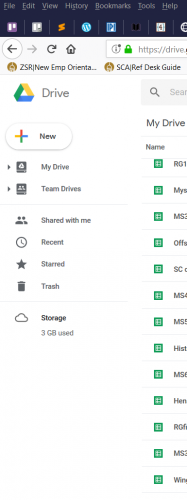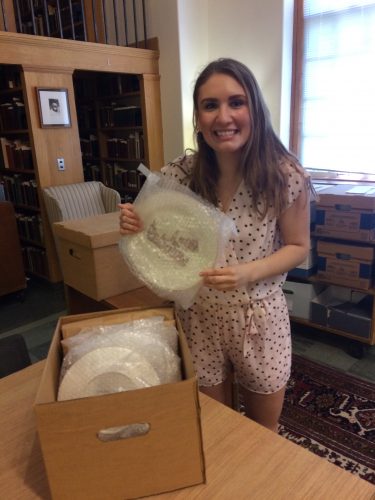This article is more than 5 years old.
We’re always working hard here, behind the scenes in Special Collections and Archives, to make our materials accessible to researchers of all kinds. Collection information that is found in our finding aids, for example this overview and collection inventory for the Office of the Provost, Edwin G. Wilson Records, helps SCA faculty and staff as well as our current and future users answer our questions!
Hopefully if you’re reading this, you’ve seen and/or used a finding aid before; if not, click on the link above, now you’re one of us! But SCA workers, from experienced archivists and librarians to our newest student assistants, take on a variety of tasks that don’t always find their way into a finding aid. A collection may require some sorting before the processing can begin in earnest. Here’s a little peek into that type of work:

- We figure out what’s what. People don’t always know what’s in their drawers, for example, but they know that all the files are related to their work. So it’s up to us to figure out what records are within the University records schedule, sort personal and professional materials, and sometimes make a first draft of an inventory so we can see how these materials are currently and can be organized.
- We rehouse materials, putting items into acid-free folders and boxes that protect paper from chemical compounds and reactions in the air and normal storage supplies. These don’t reach the level of “volatile organic compounds” (maybe you’ve heard of low-VOC paint?) but they do encourage deterioration of paper materials more quickly than acid-free containers do. This article tells you a bit about why archival quality acid-free materials are important. While the article claims that “yellow newspaper clippings and letters can be charming,” let me tell you: the yellowing just means that the item is close to crumbling and needs to be reproduced and moved!
- We maintain spreadsheets – yes, this is an active exercise! For example, when we write descriptive metadata for items like this in our Digital Collections, we do that in spreadsheet form. So someone has to organize those sheets, define parameters for all those fields, and then, after that work is done, we can fill them out. Different kinds of items are described differently, too, so we can’t just use one single template. Oral history audio files are not anything like static photographs, and so we provide different kinds of information about them. It’s fun (I promise!) but also takes time and thought.
- We keep our records up to date. Archives have a set of standards for our finding aid description, like many other professional fields have standards; these govern how we describe collections for our patrons, often in very specific detail. So we update older finding aids with new standards and work to add these to our work where possible; maybe it makes sense to employ these standards when describing digital items, for example. The more uniform and concise the information we create and maintain is, the easier it is for our reference staff and our researchers to navigate!
- We maintain our storage areas and physical collections. Libraries also have physical upkeep; most libraries do shelf reads, where we check to make sure books are where they’re supposed to be. Ever had to report to a public library that you’ve turned in a book they think you still have? A shelf reader would recover the book, hopefully! We shelf read with our closed collections, too, making sure everything is tidy and in its proper place.

It’s always fun to share how wide-ranging work with archives collections is! We do blend of physical work, like moving boxes or refoldering materials, and intellectual work, like describing items, folders of materials, or collections. And that is specific to the type of work I do and oversee as Collections Archivist. As you’ve seen on this blog, SCA hosts a variety of events, supports preservation of rare and general collection materials, and catalogs rare books and other publications, and our student workers have different kinds of experiences during their time on our team.
Soon enough the semester will come to a close and we’ll have a new list of newly processed and updated collections to share thanks to all of our staff and student assistants, but in the meantime, when you create a beautifully structured spreadsheet, know that you’re in good company: archivists and archives workers are right there with you.

5 Comments on ‘Getting the Collections to the People’
This is a thorough and thoughtful account of the wide-ranging work you (and we) do. Thanks for this record of your work as an archivist, discussion fo finding aids and preservation requirements! The work of Special Collections & Archives really shines when brought into the light. Thanks Stephanie.
I enjoyed the overview level in this post and appreciated all the links; and since I’m on the ALCTS/LITA Metadata Standards Committee, I was happy to see you link to standards in your post!
I really enjoyed this informative narrative about the important work you and your people do!
Congratulations on this impressive and informative discussion.
[…] records are preserved for the future! As to what happens after the records arrive, please see this description of our work provided by our Collection Archivist, Stephanie […]